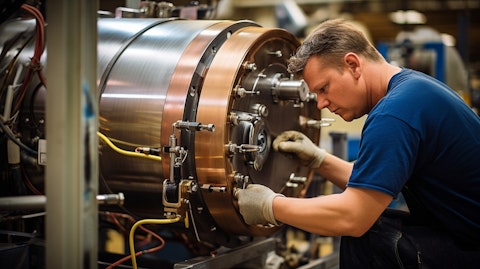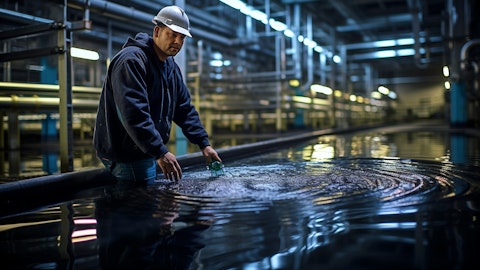A. O. Smith Corporation (NYSE:AOS) Q4 2023 Earnings Call Transcript January 30, 2024
A. O. Smith Corporation beats earnings expectations. Reported EPS is $0.97, expectations were $0.96. A. O. Smith Corporation isn’t one of the 30 most popular stocks among hedge funds at the end of the third quarter (see the details here).
Operator: Good day and thank you for standing by. Welcome to the A. O. Smith’s Fourth Quarter 2023 Earnings Conference Call. At this time, all participants are in a listen-only mode. [Operator Instructions] Please be advised that today’s conference is being recorded. I would now like to hand the call over to our first speaker for today, Helen Gurholt. Please go ahead.
Helen Gurholt: Thank you Abigail. Good morning everyone and welcome to the A. O. Smith’s full year and fourth quarter conference call. I’m Helen Gurholt, Vice President, Investor Relations and Financial Planning & Analysis. Joining me today are Kevin Wheeler, Chairman and Chief Executive Officer; and Chuck Lauber, Chief Financial Officer. In order to provide improved transparency into the operating results of our business, we provided non-GAAP measures. Free cash flow is defined as cash from operations, less capital expenditures. Adjusted earnings, adjusted earnings per share, adjusted segment earnings and adjusted corporate expenses exclude the impact of impairment charges, non-operating noncash pension income and expenses as well as legal judgment income and terminated acquisition-related expenses.
Reconciliations from GAAP measures to non-GAAP measures are provided in the appendix at the end of this presentation and on our website. A friendly reminder that some of our comments and answers during this conference call will be forward-looking statements that are subject to risks that could cause actual results to be materially different. Those risks include matters that we described in this morning’s press release, among others. Also, as a courtesy to others in the question queue, please limit yourself to one question and one follow-up per turn. If you have multiple questions, please rejoin the queue. We will be using slides as we move through today’s call. You can access them on our website at investor.aosmith.com. I will now turn the call over to Kevin to begin our prepared remarks.
Please turn to the next slide.
Kevin Wheeler: Thank you, Helen, and good morning, everyone. I’m on slide 4 in our full-year results. 2023 was a record-studying sales and earnings year, driven by resilient water heater demand and excellent execution by our team. North America sales increased 4% and adjusted segment margin increased 310 basis points due to higher water heater volumes and improved price-cost relationship. Our rest-of-wall segment, sales grew 4% in local currency as our recently introduced kitchen products in China were well-received by the market. In India, our sales grew 15% local currency in 2023 and benefited from sales of new products which represented 30% of our sales. Free cash flow grew to $598 million, primarily driven by record profit.
We returned $490 million of capital to shareholders with our dividend and share repurchases. Please turn to slide 5. Our global A. O. Smith team delivered record sales of $3.9 billion in 2023 and adjusted EPS of $3.81, a 21% increase over 2022. North America water heater sales grew 6% in 2023 due to strong demand for our residential and commercial water heater products. The residential unit industry demand increased approximately 6% compared to 2022, as new construction and proactive replacement demand remained resilient. Commercial industry units increased approximately 15% year-over-year, as volume of commercial electric water heaters greater than 55 gallons re-bounded and aligned closer to pre-2022 levels. We are pleased with our market share strength in both residential and commercial water heaters.
Our North America boiler sales decreased 12% against a difficult comp of 28% growth in 2022. We worked down our backlog in 2022 after making significant production and supply chain improvements, which led to elevated channel inventories going into 2023. The resulting channel inventory de-stocking impacted our residential and small commercial boiler sales. Sales of our CREST commercial boilers with Hellcat technology increased over 50% in 2023. North America water treatment sales from 2% in 2023, as higher sales in the e-commerce and direct-to-consumer channels were partially offset by lower sales in the wholesale and retail channels. Sales in the prior year benefited from strong shipments as supply chain constraints improved and we worked down our order backlog, which resulted in elevated channel inventories in early 2023.
In China, full year sales increased 4% in local currency. We are pleased with our performance in a continued weak economy. In addition to the successful launch of our kitchen products, we saw double digit sales growth of our HVAC and commercial water treatment product categories. Our core water heating and water treating products also performed well as replacement approaches 60% of residential water heater sales. The residential water treatment sales, particularly consumables, remain resilient. I’ll now turn the call over to Chuck, who will provide more details on our full year and four quarter performance.
Chuck Lauber: Thank you, Kevin, and good morning, everyone. I’m on slide 6. Full year sales in the North America segment rose to $2.9 billion, a 4% increase compared with 2022. Higher volumes of water heaters were partially offset by lower sales of boilers and pricing. North America segment earnings of $726 million increased 19% compared with 2022. Adjusted segment margin was 24.8%, an increase of 310 basis points year-over-year. The higher adjusted segment earnings and adjusted segment margin were primarily driven by higher water heater volumes and lower material costs. Moving to slide 7, the rest of the world’s segment sales of $957 million decreased 1% year-over-year, including unfavorable currency translation of $44 million, primarily related to China.
Segment sales increased 4% on a constant currency basis. Our sales increase was primarily driven by higher sales of kitchen products and water treatment products in China. India sales grew 15% in local currency in 2023, which is approximately three times the market. Rest of the world’s segment earnings of $99 million increased 3% compared to segment earnings in 2022, primarily due to higher sales in China. Adjusted segment operating margin was 10.4%, an increase of 40 basis points compared to 2022. Please turn to slide 8. Turning to fourth quarter performance, we delivered sales of $988 million in the fourth quarter of 2023, an increase of 6% year-over-year led by higher water heater volumes in North America and higher kitchen product sales in China that more than offset lower boiler sales and pricing.
Adjusted earnings in the fourth quarter were $0.97 per share compared with adjusted earnings of $0.86 per share in the fourth quarter of 2022. Please turn to slide 9. Fourth quarter sales in the North America segment was $738 million, a 7% increase compared to sales in the fourth quarter of 2022 as a result of higher water heating volumes partially offset by lower boiler sales. North America segment adjusted earnings of $173 million increased 8% compared with 2022. Adjusted operating margin of 23.5% increased 20 basis points compared to last year. The higher adjusted segment earnings and adjusted segment margin were primarily due to higher water heater volumes. Moving on to slide 10. Fourth quarter rest of the world’s segment sales of $260 million increased 4% year-over-year primarily driven by sales of new products partially offset by unfavorable currency translation of $3 million in China.

India sales grew 11% in local currency in 2023 compared to 2022. Rest of the world adjusted segment earnings of $30 million decreased 6% compared to Q4 2022 segment earnings. An adjusted segment margin of 11.5% decreased 120 basis points compared to segment margin in the same period last year. The decreases were primarily due to promotions and advertising supporting the launch of our dishwasher and steam oven products in China. Please turn to slide 11. We generated pre-cash flow of $598 million during 2023, an increase of 86% over 2022 primarily driven by higher earnings and lower working capital needs. In 2023, pre-cash flow conversion was 107%. Our cash balance totaled $363 million at the end of December and our net cash position was $236 million.
Our leverage ratio was 6.5% as measured by total debt to total capital. Now turn to slide 12. As we detail at our investor day, in addition to returning capital to shareholders, we continue to see opportunities for organic growth, innovation, and new product development across all of our product lines and geographies. We target strategic acquisitions that meet our financial metrics of the creative earnings in the first year and return our cost to capital in three years. The strength of our balance sheet allows us to continue to invest in ourselves through research and development and capital expansion while pursuing strategic acquisitions. Earlier this month, our board approved our next quarterly dividend of $0.32 per share. We have increased our dividend for over 30 consecutive years.
We repurchased approximately 4.4 million shares of common stock in 2023 for a total of $307 million. We continue our strong track record of delivering return to shareholders. Over the last two years, we have returned over $1 billion to shareholders through our dividends and share repurchases. Please turn to slide 13 in our 2024 earnings, guidance, and outlook. We are pleased to introduce our 2024 outlook with an expected EPS range of $3.90 and $4.15 per share. The midpoint of our EPS range represents an increase of 6% compared with 2023 adjusted EPS. Our outlook is based on a number of key assumptions, including our guidance assumes that steel prices in 2024 will be a slight headwind compared to 2023. Relative to current steel prices, our projection includes a decline in steel price index in the second half of the year.
Our outlook assumes non-steel material costs are similar in 2024, as they were in 2023. Our guidance also assumes a relatively stable supply chain environment similar to what we experienced throughout 2023. We are monitoring the situation in the Red Sea in Panama, and currently have not experienced any negative impacts. We launched our internally designed and manufactured gas tankless products earlier this month. As we mentioned at our investor day, these products will be manufactured in China facility until our North America capacity is completed in 2025. Associated import tariffs and other launch costs will impact North America margins by approximately 50 basis points. We are investing in manufacturing in Juarez, Mexico that will eliminate the tariff in the future.
For the year, CapEx should be between $105 million and $115 million. An increase over the last several years due to capacity expansion projects related to our gas tankless manufacturing facility in Juarez, the expansion of our engineering capabilities in Lebanon and Tennessee, and an increase in high-efficiency commercial water heating manufacturing capacity to align with regulatory changes coming in 2026. We expect to generate strong pre-cash flow between $525 million and $575 million. Corporate and other expenses are expected to be approximately $60 million. Our effective tax rate is estimated to be between 24 and 24.5% , and we expect to repurchase $300 million of shares of our stock, resulting in our outstanding diluted shares of $147 million at the end of 2024.
I’ll now turn the call back over to Kevin, who will provide more color on our key markets and top-line growth outlook and segment expectations for 2024, staying on slide 13. Kevin?
Kevin Wheeler: Thank you, Chuck. We project 2024 sales to grow between 3% and 5% compared to 2023, which includes the following assumptions. We believe the U.S. new home construction remains in a deficit, and we project it will be flat in 2023. We also assume that 2024 proactive replacement will remain at a level similar to 2023. Therefore, after an approximate 6% increase in the industry in 2023 compared to 2022, we project that 2024 residential industry unit volumes will be approximately flat until last year. We project U.S. commercial water heater industry volumes to increase low single digits, as demand for our commercial electric greater than 55 gallons continues its positive trend to pre-2022 levels. In addition, our outlook includes the announced price increases in North America water heating of 4% on most of our water heater products.
Price increase for heat pump products is 8%. These increases are projected to be effective late in the first quarter. In China, we believe it will take time for the economy to improve amid weakened consumer confidence in a challenged real estate and housing market, and we have not yet seen signs of significant improvement. Even with the continued backdrop of a weak economy, we project our sales in China will again grow 3% to 5% and local currency in 2024, driven by resilient replacement demand, growth in demand for our water treatment products, and our recently released kitchen products. Our forecast assumes that the currency translation impact will be minimal in 2024. We expect a return to growth in our North America boiler business, with a projected sales increase of between 8% to 10% in 2024.
We expect a continued benefit from the transition to higher energy efficient boilers, particularly as commercial buildings look to improve their overall carbon footprint. We predict sales of North America water treatment products to increase approximately 10% to 12%, as we expect to grow at two times the pace of the market. Based on our 2024 assumptions, we expect our North America segment margin to be between 24.5% and 25% and rest of world’s segment margin to be approximately 10%. Please turn to slide 14. I’d like to thank everyone who joined us at our investor date late last year, either in person or via webcast. The recording of the webcast is available on our website. The team and I enjoyed sharing the exciting growth opportunities that we see on the horizon for all of our businesses.
A summary of the key topics that we covered are on slide 14. I look forward to sharing periodic updates on our initiatives, including the launch of our gas tankless products. As we looked at 2024, we remained focused on our key strategic priorities to advance our position as a leader in heating and treating water around the world. Those priorities are expanding and enhance our high efficiency product portfolio, including heat pumps for space and water heating, expand our global water treatment capabilities by investing in technologies, people, and geographic expansion, and deploy capital effectively by investing in our south, pursue our active acquisition pipeline, and returning capital to shareholders. We have many reasons to have optimism as we enter 2024.
We see strong and market demand in North America for all of our product categories, and we expect to return to growth for boilers and North American water treatment as we believe our customers exited 2024-2023 with normalized channel inventories. We have begun several capacity expansion projects in North America that will support our growth in the long term. In China, we are projecting a second year of growth driven by innovative new products and resilient demand for our core products, and we expect to continue double-digit growth in India as our premium products and customer service are well-received in the market. And finally, this year marks an important milestone for A.O. Smith as we celebrate our 150th anniversary. What began as a small machine shop in Milwaukee, Wisconsin in 1874 has grown into an innovative industry leading global water technology company with more than 12,000 employees.
A.O. Smith has a rich and proud history, and we are excited to celebrate it with employees, shareholders, customers, and partners across the globe. With that, we conclude our prepared remarks, and we are now available for your questions.
See also Here is How Billionaire Chris Hohn’s Hedge Fund Beat the Market with 33% Gain and Light Street Capital Returned 46% in 2023: Top 15 Picks.
Q&A Session
Follow Smith A O Corp (NYSE:AOS)
Follow Smith A O Corp (NYSE:AOS)
Operator: Thank you. At this time, we will conduct the question and answer session. [Operator Instructions] Our first question comes from Michael Halloran with Baird. Your line is open.
Michael Halloran: Hey, morning, everyone.
Kevin Wheeler: Good morning, Mike.
Michael Halloran: So, I figured after last time where I had issues on my end getting through, I figured I’d give a [indiscernible] pause there, so make sure you guys could hear me.
Kevin Wheeler: We can. I hope you can hear us also.
Michael Halloran: Yes. Great. So, two questions here, both on North America. First, could you give some context to how you’re thinking about the moving pieces within the residential water heater business between discretionary replacement, new build, and the non-discretionary replacement pieces?
Chuck Lauber: Yes, I’ll touch on that. We don’t see much difference in 2024 as we forecasted in our guidance that 9.2 million new construction, whether it’s single family or multifamily, continues to progress. And we see it flat. And the proactive replacement has stayed very resilient. It’s been six to eight quarters now. We just received data from it recently, and it continues to move down that path. And, of course, the [emergency] replacement is a non-discretionary, and we expect that to continue. So, we look at really 2024 as having a very similar outlook as 2023.
Kevin Wheeler: And maybe I’ll just comment, Mike, that, it’s been a couple lumpy years, right? I mean, we’ve had COVID and been a bit of a correction last year. We think the industry this year will be up maybe in that 5.5% to 6%. But if we kind of step back to 2019 and just look at a growth rate of 1.5%, we kind of we end up at what we think our outlook is going to be for 2024, along with, those assumptions that Kevin just mentioned. So it feels like a fairly stable residential market for us as we go into ’24.
Michael Halloran: Got it. And just to be clear, the 6-ish percent was a 20 or 2023 reference point. Right?
Chuck Lauber: Yes, it was ’23 over ’22. I always trip up as we go into the next year here.
Michael Halloran: Yes, no, same page, me too. So second question, then, is just putting the North American margins in context. They certainly get the 50 basis point headwind from the investments you’re making. Did you talk about why the confidence that down steel costs, the lower levels of inflation or limited inflation remaining, and then, maybe in the context of what you saw in the fourth quarter and how that will ramp through the year? I know a lot in there, but just looking for a little bit more color around that North America margin guide?
Chuck Lauber: Yes. So we see steel cost as a slight headwind as we go into the year. Steel cost have been kind of in that bandwidth and I’ll quote, coal rolled of 950 to 1300, 1350. I mean, it’s been in that bandwidth at the higher end of that bandwidth right now. So, as we come out of the fourth quarter, we’re going to see a little bit of help on steel in the first quarter. And then we’re going to see steel ramp up again in the back, back three quarters, likely, although we’re calling out slight relief in the back half of the year. Fortunately, we have pricing coming in when steel kind of comes in the second quarter. So, as we come out of 2023, we’re looking at a little bit better margin profile in the first quarter because it’s down slightly and then get helped a little bit on pricing coming in with a higher cost deal.
If you kind of look at the cadence for the year, kind of most quarters in North America are within that bandwidth of range, or at least pretty close in the 24.5% to 25% bandwidth. I’d say Q1 has maybe a little more pressure. And then, of course, as you mentioned, we do have some headwinds. Just, launching our tankless product is about a 50 basis point headwind as we import out of China, do the transportation and then, continue to promote that product.
Operator: One moment for our next question. Our next question comes from Jeff Hammond with KeyBanc Capital Markets. Your line is open.
Jeff Hammond: Hey, good morning, everyone.
Chuck Lauber: Hey, Jeff.
Kevin Wheeler: Hey, Jeff.
Jeff Hammond: Just trying to get a sense of feedback from the channel on the March pricing, you guys put through quite a bit. I think we were a little surprised to see a follow-on here, but maybe just speak to how the channels react into it and what’s kind of supporting that price increase. Thanks.
Kevin Wheeler: Yes. I would just tell you that our philosophy has always been on pricing that we feel the cost before our customers do. And so as much as steel bounces up and down, there’s still other parts of components and other chemicals and so forth. And so our increase is always based on what we have to address going forward with our suppliers. And the cadence, it’s off a little bit. We pushed it out to March, and that’s pretty rare, but it happens on occasion. Our goal has always been and will continue to be to keep our customers competitive and the price increase along with the timing really reaches that goal for us.
Jeff Hammond: Okay. And then just on the boiler, you’ve seen any kind of inflection in boiler demand or has this just growth off of easy comps?
Kevin Wheeler: It’s certainly coming off some comps. You can get a reminder, first quarter of last year was a pretty good year, a strong quarter for us on the boiler side. And we didn’t see stocking until starting in the second quarter. But much of it has to do with coming off some comps, inventories coming down, getting back to our regular cadence. And we always get a little tripped up on sell out or sell in. You remember our sell in was down, but our sell out, we felt we held our own in the market. So overall, the boiler market is slightly down on some quoting. Residential has been a headwind for us most of the year that we look at turning that around in 2024. But overall, the market is a combination of comps and some of our new products. Our CREST with LCAP technology continues to grow. We outlined how much it’s growing this year or last year. So a combination of getting back to our normal cadence and some new product offerings is how we get to that 8% to 10%.
Operator: One moment our next question. Our next question comes from Susan Maklari with Goldman Sachs. Your line is open.
Susan Maklari: Thank you. Good morning, everyone.
Kevin Wheeler: Good morning, Susan.
Susan Maklari: My first question is going back to that discretionary demand on the residential water heaters. You’ve obviously seen that in the last several years. You’ve talked to that holding fairly flat for 2024. When we think about that relative to some other categories, such as appliances where we’re seeing that discretionary demand has been weaker just sort of across our building products coverage, what gives you the confidence that that will hold this year? And any additional thoughts on where that may trend over time?





